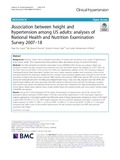Association between height and hypertension among US adults: Analyses of National Health and Nutrition Examination Survey 2007–18
Citation
Gupta, R. D., Akonde, M., Sajal, I. H., & Al Kibria, G. M. (2021). Association between height and hypertension among US adults: analyses of National Health and Nutrition Examination Survey 2007-18. Clinical hypertension, 27(1), 6. https://doi.org/10.1186/s40885-021-00164-4Abstract
Background: Previous studies that investigated association of height with prevalence and control of hypertension
found mixed results. This cross-sectional study explored these associations among US adults (≥20 years).
Methods: The National Health and Nutrition Examination Survey (NHANES) 2007–18 data was analyzed. Height was
measured in meters and was converted into centimeters (cm) and was further divided into quartiles: Q1 (135.3–159.2 cm),
Q2 (159.3–166.2 cm), Q3 (166.3–173.6 cm), Q4 (173.7–204.5 cm). Hypertension definition of the ‘2017 American College of
Cardiology/American Heart Association Guideline’ was used. Logistic regression analyses were conducted to find out the
association between the dependent variable and the covariates. Linear regression analyses were conducted to find out the
association of height with systolic blood pressure (SBP), diastolic blood pressure (DBP), pulse pressure (PP), and the covariates
among the individuals who were not taking any antihypertensive drugs. Crude odds ratio, adjusted odds ratio (AOR), and
adjusted beta-coefficient (for linear regression) with 95% confidence interval (CI) were reported. The following covariates
were included: age, gender, race/ethnicity, family income, education level, cholesterol level, high-density lipoprotein level,
chronic kidney disease status, diabetes status, smoker, aerobic leisure-time physical activity, and survey period. Sample weight
of NHANES was adjusted.
Results: Among the 21,935 participants (47.1% males), the prevalence of hypertension was 46.1%. Among 6154
participants taking medication (43.0% males), 57.2% had uncontrolled hypertension. In the final logistic regression
analyses, participants in Q2 height quartile had 20% lower odds of being hypertensive compared to those in Q4 height
quartile (AOR: 0.8; 95% CI: 0.7,1.0). Other height categories did not reveal any significant association. Compared to Q4
height category, Q1 (AOR: 1.7; 95% CI: 1.2,2.3), Q2 (AOR: 1.4; 95% CI: 1.1,1.8), and Q3 (AOR: 1.3; 95% CI: 1.1,1.6) height
categories had higher odds of uncontrolled hypertension. PP was inversely associated and DBP was positively
Conclusions: Although height was not associated with prevalence of hypertension, it had inverse association with
uncontrolled hypertension. It was also significantly associated with DBP and PP among the individuals with untreated
hypertension.

